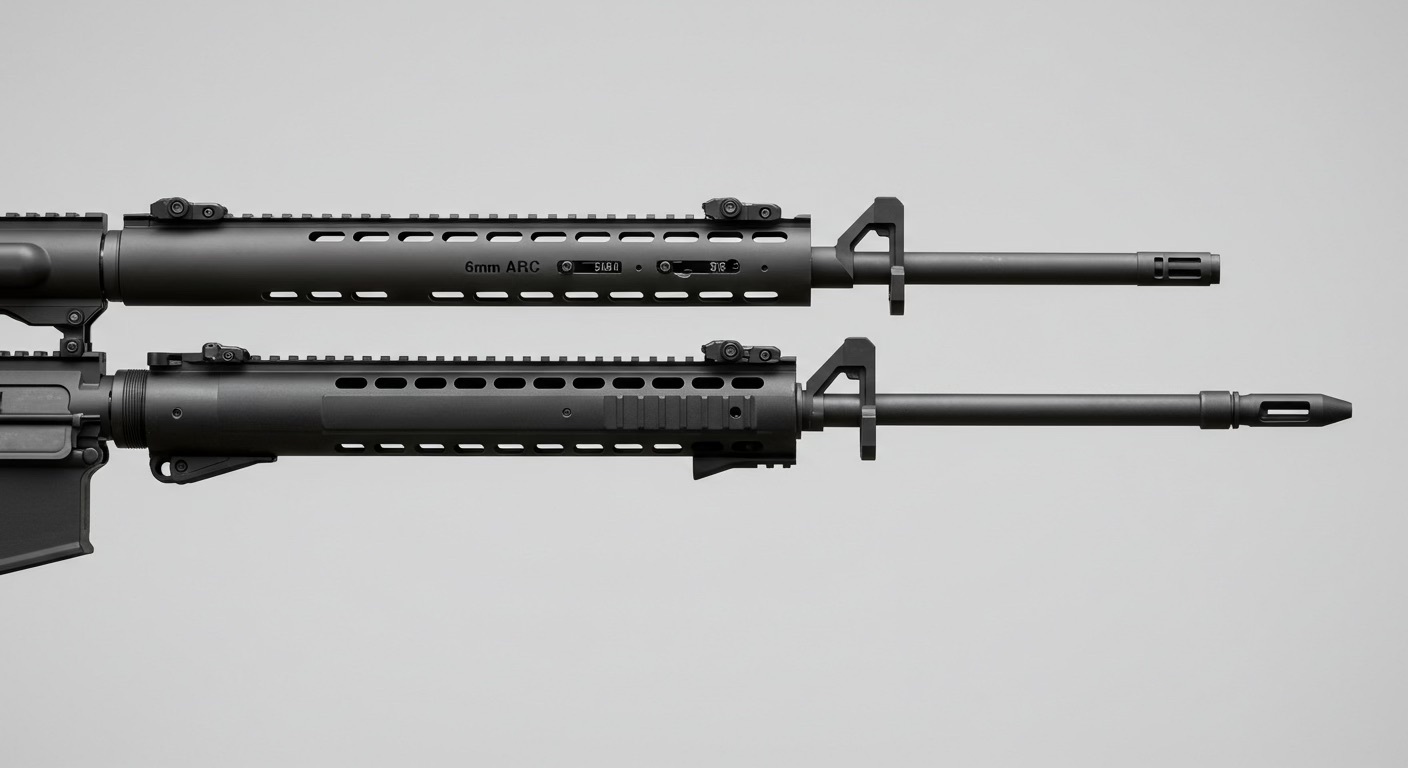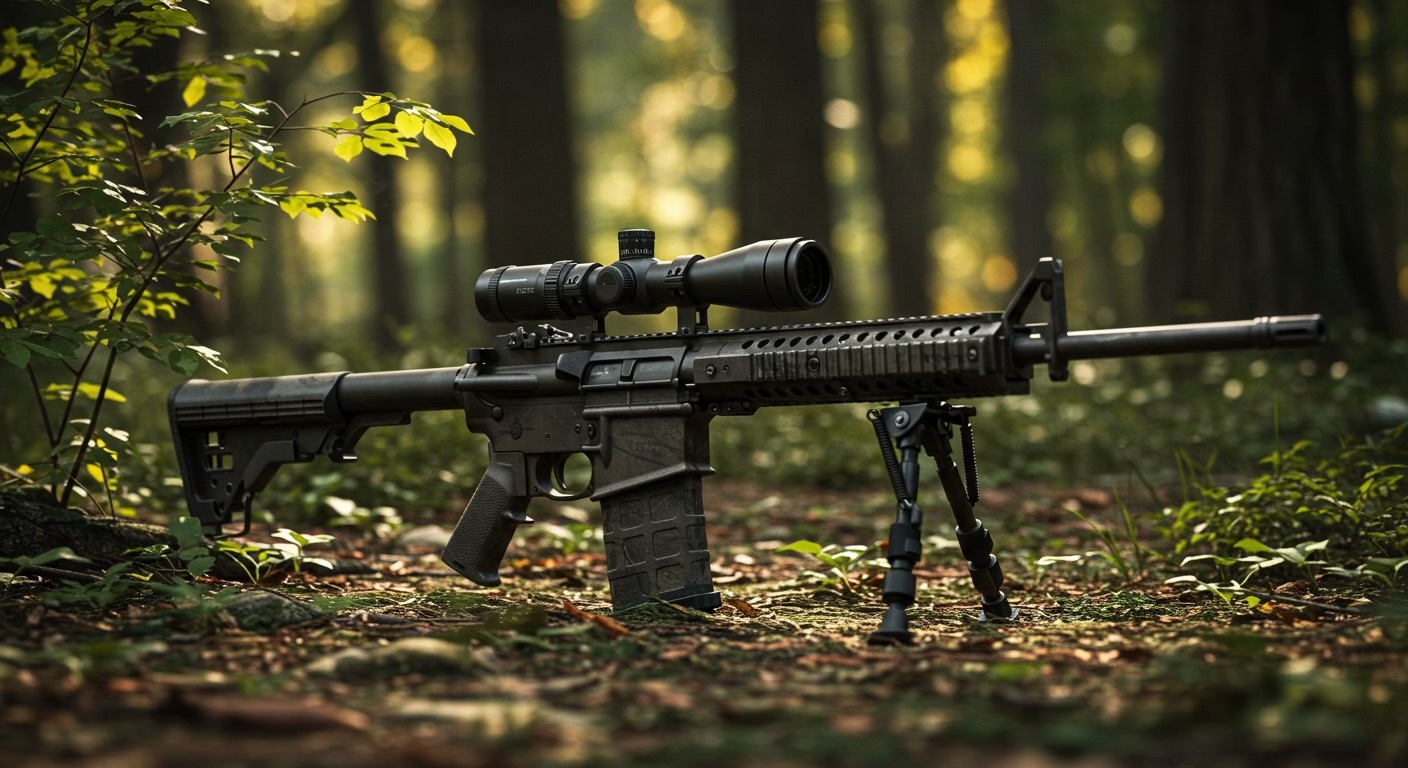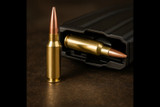When it comes to medium-range precision shooting, cartridge selection can make all the difference between hitting your target and missing the mark. The 6mm ARC and 224 Valkyrie have emerged as two of the most popular options for AR-15 platform shooters seeking enhanced ballistic performance beyond what traditional .223/5.56 rounds can deliver.
Both cartridges promise extended effective ranges, improved wind resistance, and enhanced terminal performance, but which one truly delivers on these promises? This comprehensive comparison will examine these two powerhouse cartridges across multiple performance metrics to help you make an informed decision for your next build.
At AR15 Parts, we've seen growing interest in both cartridges among our customers looking to upgrade their precision shooting capabilities.
Where 6mm ARC and 224 Valkyrie Come From and Why It Matters
The 224 Valkyrie and 6mm ARC represent different approaches to solving the same problem: creating a cartridge that extends the effective range of the AR-15 platform without requiring extensive modifications.
Federal Premium introduced the 224 Valkyrie in 2017, developing it from the 6.8 SPC case necked down to .224 caliber. The primary design goal was creating a cartridge capable of maintaining supersonic velocity beyond 1,300 yards while generating manageable recoil in standard AR-15 platforms.
The 224 Valkyrie quickly gained popularity among precision shooters and competitors looking for improved long-range performance. In contrast, Hornady unveiled the 6mm ARC (Advanced Rifle Cartridge) in 2020 as a direct response to military requirements for enhanced medium-range performance.
Based on the 6.5 Grendel case necked to 6mm, the ARC was specifically designed to optimize the balance between terminal ballistics, trajectory, and recoil management. When selected for special operations forces applications, the cartridge received a significant credibility boost.
Both cartridges represent relatively recent innovations, but they've quickly established dedicated followings within the precision shooting community, with AR15 Parts seeing steady demand for components in both calibers since their introduction.
Ballistics Breakdown: Velocity, Trajectory, and Wind Drift Head to Head
When examining ballistic performance, we need to consider several key metrics: muzzle velocity, energy, trajectory, and wind drift. These factors determine how effectively each cartridge performs at various distances.
The 6mm ARC typically pushes a 103-108 grain bullet at approximately 2,750-2,800 fps from an 18-inch barrel. This generates roughly 1,700-1,800 ft-lbs of muzzle energy. The heavier bullets and slightly larger diameter provide excellent ballistic coefficients, typically ranging from .512 to .545, depending on the specific projectile.
The 224 Valkyrie, with its smaller diameter bullets, usually launches 60-90 grain projectiles at velocities between 2,700-3,000 fps from similar barrel lengths. This translates to approximately 1,300-1,600 ft-lbs of muzzle energy. The highest BC bullets in 224 Valkyrie typically achieve coefficients around .447 to .535.
In practical terms, the 6mm ARC maintains a flatter trajectory past 600 yards and demonstrates superior wind drift resistance. For example, with a 10 mph crosswind at 800 yards, a 108gr 6mm ARC ELD Match bullet might drift approximately 29 inches compared to 33 inches for a 90-grain 224 Valkyrie Sierra MatchKing.
For shooters considering these performance advantages, the 18" 6MM ARC Barrel - Ballistic Adv - SPR provides an excellent foundation for building a precision rifle capable of maximizing the cartridge's potential.
Which Round Is Easier on Your Barrel and Worth the Long-Term Investment?

Barrel life represents a significant consideration for precision shooters, particularly those who put high round counts through their rifles during competition or training. The 6mm ARC, with its larger bore diameter and generally lower pressure (52,000 psi max), typically delivers longer barrel life than comparable cartridges.
Most shooters report maintaining match-grade accuracy for approximately 2,000-3,000 rounds before noticeable degradation occurs. This longer service life partly explains why many competition shooters have gravitated toward the 6mm ARC despite its relative newness.
The 224 Valkyrie operates at similar pressure levels (55,000 psi max) but uses a smaller diameter bullet pushed at high velocity through a tight bore. This combination accelerates throat erosion, with most shooters reporting barrel life spans of approximately 1,500-2,200 rounds before precision begins to decline meaningfully.
The smaller bore also makes the Valkyrie somewhat more sensitive to carbon buildup, potentially requiring more frequent cleaning. For both cartridges, barrel steel quality and heat treatment significantly impact longevity.
Premium barrels with proper cryogenic treatment and stress relief can extend useful life by 30% or more compared to budget options. Appropriate cleaning protocols and avoiding rapid-fire strings that overheat the barrel will also preserve accuracy potential.
Cost and Component Access: What You’ll Pay to Shoot Each Caliber
Ammunition and component availability represent a crucial factor for many shooters, particularly during periods of high demand or supply chain disruptions.
224 Valkyrie enjoyed an early advantage in factory ammunition availability, with Federal Premium offering multiple loads from the outset. Today, most major manufacturers produce Valkyrie ammunition, with options from Hornady, Nosler, and Winchester readily available. Factory ammunition typically costs between $1.25-$2.00 per round, depending on quality, with match-grade options at the higher end.
The 6mm ARC initially faced more limited factory ammunition options, with Hornady being the primary source. However, by 2023-2024, availability expanded significantly with Federal, Nosler, and Berger offering factory loads. Prices generally run between $1.40-$2.25 per round, making it slightly more expensive than Valkyrie on average.
For reloaders, both cartridges use readily available components:
- Brass Options: Hornady, Lapua, and Peterson for 6mm ARC; Federal, Hornady, and Starline for 224 Valkyrie
- Bullets: Abundant choices in both calibers, with particular strength in 6mm match options
- Primers and Powders: Similar requirements, typically using small rifle primers and medium-burning powders
The overall cost difference for reloaders is minimal, with 6mm ARC components costing approximately 5-10% more than comparable 224 Valkyrie components based on current market pricing.
Hardware Requirements and Compatibility for Building in Each Caliber

Both cartridges are designed specifically for the AR-15 platform, but they require different components for optimal performance.
The 224 Valkyrie requires:
- Dedicated barrel with 1:7 or 1:6.5 twist rate
- 6.8 SPC bolt (Type 2 preferred)
- 6.8 SPC magazines
The 6mm ARC requires:
- Dedicated barrel with 1:7.5 or 1:8 twist rate
- 6.5 Grendel bolt
- 6.5 Grendel magazines
For shooters looking to build a complete upper, the 18" 6MM ARC Complete Upper - Satern Medium SS offers a turnkey solution that includes all the necessary components properly matched for optimal performance.
Both cartridges utilize the same gas system lengths (typically mid-length for 18" barrels) and buffer requirements. This means that converting an existing AR-15 to either caliber requires similar levels of modification, primarily centered on the barrel, bolt, and magazines.
An important compatibility consideration: neither cartridge works well in barrels shorter than 16 inches due to velocity loss, with optimal performance typically seen in 18-24 inch barrels. This makes them better suited for precision, hunting, or tactical applications rather than close-quarters use.
What Each Cartridge Does Best in Real-World Shooting Scenarios
The ballistic characteristics of each cartridge make them better suited for certain applications:
The 6mm ARC excels in:
- Medium to long-range precision shooting (400-1,000 yards)
- Hunting medium game like deer and antelope
- Tactical applications requiring consistent performance across varied distances
- Competitive shooting, where wind drift resistance is critical
The 224 Valkyrie particularly shines in:
- Varmint and predator hunting where an explosive effect is desired
- Long-range paper punching and steel ringing
- Situations where reduced recoil is the primary concern
- Applications where magazine capacity is prioritized
One customer at our shop built a 6mm ARC using an 18" barrel primarily for western whitetail hunting. He reported consistent sub-MOA accuracy with 103-grain ELD-X bullets and successful harvests out to 425 yards, with excellent terminal performance and minimal meat damage.
The rifle weighed 8.2 pounds fully equipped, light enough for all-day carrying but stable enough for precision shooting from field positions.
Which Round Delivers Better On-Target Impact for Ethical Hunting

Terminal performance represents perhaps the most significant divergence between these two cartridges, primarily due to their different bullet diameters and available projectile options.
The 224 Valkyrie, with its .224" diameter bullets, is somewhat limited in hunting applications by bullet construction and weight. The cartridge performs exceptionally well on varmints and predators using 60-75 grain projectiles, delivering explosive fragmentation.
For deer-sized game, heavier 90-grain bullets are required, and even then, shot placement becomes critical as the smaller diameter provides less margin for error. Most jurisdictions allow .224 caliber for deer hunting, but it represents the minimum acceptable diameter in many regions.
The 6mm ARC's .243" diameter bullets offer approximately 18% more frontal area, translating to improved terminal performance on medium game. The 103-108 grain hunting bullets expand reliably at the velocities the ARC generates, even at extended ranges.
This has made the 6mm ARC increasingly popular among hunters seeking an AR-platform rifle for deer, antelope, and similar-sized game. The cartridge effectively bridges the gap between varmint rounds and dedicated big game cartridges.
Both cartridges maintain sufficient energy for ethical harvests of appropriate game out to 400+ yards:
- 6mm ARC: Approximately 1,000 ft-lbs at 400 yards (108gr ELD-X)
- 224 Valkyrie: Approximately 850 ft-lbs at 400 yards (90gr Sierra GameKing)
Frequently Asked Questions
Which cartridge has less recoil: 6mm ARC or 224 Valkyrie?
The 224 Valkyrie generally produces less felt recoil than the 6mm ARC, though both are considered mild-recoiling cartridges. In typical rifle configurations, the 224 Valkyrie generates approximately 3.5-4.0 ft-lbs of recoil energy, while the 6mm ARC produces about 4.5-5.0 ft-lbs.
This difference is noticeable but not dramatic, and both cartridges allow for quick follow-up shots and extended practice sessions without fatigue. Factors like rifle weight, buffer system, and muzzle device can further influence perceived recoil.
Can I use my existing AR-15 lower receiver with either cartridge?
Yes, both the 6mm ARC and 224 Valkyrie are designed to function with standard AR-15 lower receivers. The modifications required are limited to the upper receiver components (primarily barrel and bolt) and magazines.
Your existing lower receiver, including the buffer system, trigger group, and other components, will work without modification. This compatibility represents one of the major advantages of both cartridges, allowing shooters to expand their rifle's capabilities without investing in an entirely new platform.
Which cartridge is better for long-range target shooting?
For pure long-range target shooting beyond 600 yards, the 6mm ARC typically holds an advantage due to its superior ballistic coefficient and wind-bucking capability. The heavier 6mm bullets (103 - 108 grains) maintain velocity better and drift less in crosswinds compared to the lighter 224 Valkyrie projectiles.
However, the Valkyrie can be highly competitive out to 800 yards, particularly with premium 90-grain bullets. Your shooting environment should influence your choice; if you frequently contend with windy conditions, the 6mm ARC provides a meaningful advantage.
How does ammunition availability compare between the two cartridges?
As of 2025, the 224 Valkyrie still maintains a slight edge in factory ammunition availability, being available from more manufacturers and in more retail locations. However, the gap has narrowed significantly in recent years, with 6mm ARC ammunition now produced by major manufacturers including Hornady, Federal, and Nosler.
For reloaders, components for both cartridges are readily available, though 6mm match bullets typically offer more options at the higher ballistic coefficient range. During ammunition shortages, both specialty cartridges may become difficult to find, making reloading capability valuable.
Can these cartridges be used effectively in barrels shorter than 18 inches?
While both cartridges will function in barrels shorter than 18 inches, significant performance penalties occur with shorter barrels. The 224 Valkyrie loses approximately 50-60 fps per inch below 18", while the 6mm ARC loses about 40-50 fps per inch.
This velocity loss affects both trajectory and terminal performance. The 6mm ARC tends to perform slightly better in shorter barrels (16") than the Valkyrie due to its more efficient powder burn rate. Neither cartridge is recommended for barrels shorter than 16 inches, as the velocity loss becomes too significant to maintain their ballistic advantages over traditional options like 5.56 NATO.
Final Thoughts on Choosing Between 6mm ARC and 224 Valkyrie
Both the 6mm ARC and 224 Valkyrie offer significant performance improvements over traditional .223/5.56mm options, but they excel in slightly different applications. The 6mm ARC has emerged as the superior option for hunters and precision shooters prioritizing wind performance and terminal ballistics, while the 224 Valkyrie retains advantages in recoil management and factory ammunition selection.
Your specific shooting requirements should guide your choice between these excellent cartridges. Regardless of which you select, both represent the cutting edge of AR-15 platform performance enhancement and provide capabilities previously unavailable in America's most popular rifle format.
Contact our specialists for personalized advice on selecting the right barrel, components, and accessories for your next precision build.
Contact AR15 Parts to Build Better with Proven Components
At AR15 Parts, we help shooters make informed choices between cartridges like 6mm ARC and 224 Valkyrie with the right barrels, bolts, and uppers for any precision build.
Whether you're dialing in for long-range accuracy or building a hunting rig, we’ve got the components and support to help you hit your goals. Need help choosing parts for your next caliber upgrade? Reach out to AR15 Parts today. Our team is ready to help you build smarter and shoot better.

